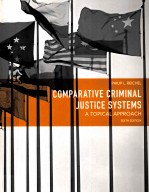

COMPARATIVE CRIMINAL JUSTICE SYSTEMS A TOPICAL APPROACH SIXTH EDITIONPDF电子书下载
- 电子书积分:12 积分如何计算积分?
- 作 者:PHILIP L.REICHEL
- 出 版 社:PEARSON
- 出版年份:2013
- ISBN:
- 页数:350 页
Chapter 1 AN INTERNATIONAL PERSPECTIVE 1
Learning Objectives 1
Countries in Focus 1
Why Study the Legal System of Other Countries? 3
Provincial Benefits of an International Perspective 3
Universal Benefits of an International Perspective 5
Approaches to an International Perspective 11
Historical Approach 12
Political Approach 13
Descriptive Approach 14
Strategies Under the Descriptive Approach 15
The Functions/Procedures Strategy 15
The Institutions/Actors Strategy 17
Comparison Through Classification 17
The Need for Classification 17
Classification Strategies 18
The Role of Classification in this Book 19
The Structure of this Book 20
Summary 21
Discussion Questions 22
Notes 22
Chapter 2 DOMESTIC CRIME, TRANSNATIONAL CRIME,AND JUSTICE 24
Learning Objectives 24
Countries in Focus 24
Comparative Criminology and Criminal Justice 25
Comparative Criminology Looks at Crime as a Social Phenomenon 25
Comparative Criminology Looks at Crime as Social Behavior 32
Transnational Crime 33
Transnational Crime Types 34
Response to Transnational Crime 45
National Efforts: The United States of America 45
International Efforts 48
Summary 51
Discussion Questions 51
Notes 51
Chapter 3 AN AMERICAN PERSPECTIVE ON CRIMINAL LAW 55
Learning Objectives 55
Countries in Focus 55
Essential Ingredients of Justice Systems 56
Substantive Criminal Law 57
Procedural Criminal Law 64
Liberty, Safety, and Fighting Terrorism 70
The USA PATRIOT Act—Substantive and Procedural Law Issues 70
Is America’s Reaction That Different? 72
Summary 75
Discussion Questions 76
Notes 76
Chapter 4 LEGAL TRADITIONS 79
Learning Objectives 79
Countries in Focus 79
Legal Systems and Legal Traditions 80
Today’s Four Legal Traditions 82
Common Legal Tradition 84
Civil Legal Tradition 88
Islamic (Religious/Philosophical) Legal Tradition 91
Eastern Asia (Hybrid) Legal Tradition 98
Comparison of the Legal Traditions 101
Cultural Component 102
Substantive Component 106
Procedural Component 107
Summary 111
Discussion Questions 111
Notes 111
Chapter 5 SUBSTANTIVE LAW AND PROCEDURAL LAW IN THE FOUR LEGAL TRADITIONS 114
Learning Objectives 114
Countries in Focus 114
Substantive Criminal Law 115
General Characteristics and Major Principles 115
Substantive Law in the Common Legal Tradition 118
Substantive Law in the Civil Legal Tradition 120
Substantive Law in the Islamic Legal Tradition 122
Substantive Law in the Eastern Asia Legal Tradition 125
Procedural Criminal Law 127
Adjudicatory Processes 129
Judicial Review 139
Summary 145
Discussion Questions 146
Notes 146
Chapter 6 AN INTERNATIONAL PERSPECTIVE ON POLICING 150
Learning Objectives 150
Countries in Focus 150
Classification Of Police Structures 151
Centralized Single Systems: Ghana 153
Decentralized Single Systems: Japan 155
Centralized Multiple Coordinated Systems: France 159
Decentralized Multiple Coordinated Systems: Germany 164
Centralized Multiple Uncoordinated Systems: Spain 167
Decentralized Multiple Uncoordinated Systems: Mexico 169
Policing Issues: Police Misconduct 174
Policing Issues: Global Cooperation 175
International Criminal Police Organization (ICPO)—Interpol 175
Europol 177
Examples of Harmonization and Approximationin the European Union 178
Summary 180
Discussion Questions 180
Notes 181
Chapter 7 AN INTERNATIONAL PERSPECTIVE ON COURTS 184
Learning Objectives 184
Countries in Focus 184
Professional Actors in the Judiciary 186
Variation in Legal Training 186
Variation in Prosecution 188
Variation in Defense 192
The Adjudicators 195
Presumption of Innocence 197
Professional Judges 197
Lay Judges and Jurors 199
Examples along the Adjudication Continuum 201
Variation in Court Organization 207
France 208
England and Wales 212
Nigeria 215
China 217
Saudi Arabia 220
Summary 222
Discussion Questions 222
Notes 223
Chapter 8 AN INTERNATIONAL PERSPECTIVE ON CORRECTIONS 227
Learning Objectives 227
Countries in Focus 227
Comparative Penology 228
Typologies for Comparative Penology 228
Punishment 231
Justifications for Punishment 231
International Standards for Corrections 232
Financial Penalties 233
Fines 233
Compensation to Victims and Community 235
Corporal and Capital Punishment 237
International Standards 237
Corporal Punishment 238
Capital Punishment 239
Noncustodial Sanctions 246
International Standards 246
Community Corrections 246
Probation 247
Custodial Sanctions 250
International Standards 250
Prison Populations 251
Prison Systems 253
Women in Prison 258
Minorities in Prison 261
Summary 263
Discussion Questions 263
Notes 263
Chapter 9 AN INTERNATIONAL PERSPECTIVE ON JUVENILE JUSTICE 269
Learning Objectives 269
Countries in Focus 269
Delinquency as a Worldwide Problem 270
Setting International Standards 272
Determining who are Juveniles 273
Determining the Process 275
Models of Juvenile Justice 275
The Welfare Model of New Zealand 276
Italy: More Welfare than Justice Model 279
China: More Justice than Welfare Model 281
The Justice Model of England and Wales 284
Summary 289
Discussion Questions 290
Notes 290
Chapter 10 JAPAN: EXAMPLES OF EFFECTIVENESS AND BORROWING 293
Learning Objectives 293
Countries in Focus 293
WhyStudyJapan? 294
Japan’s Effective Criminal Justice System 294
Borrowing in a Cross-Cultural Context 295
Japanese Cultural Patterns 297
Homogeneity 297
Contextualism and Harmony 298
Collectivism 299
Hierarchies and Order 299
Criminal Law 301
Law by Bureaucratic Informalism 301
Policing 302
Why Are the Japanese Police Effective? 303
Judiciary 306
Pretrial Activities 308
Court Structure and Trial Options 314
Judgments 318
Corrections 318
Community Corrections 319
Prison Sentences 320
Coming Full Circle 321
What Might Work 321
Summary 323
Discussion Questions 324
Notes 324
Appendix A World Maps 327
Appendix B Helpful Web Sites 335
Index 336
- 《全局光照算法技术》(美)菲利普·特瑞(Philip Dutre)等著 2019
- 《经典飞机》Philip Jarrett 2019
- 《新默示录 影印本》(英)Philip Gibbs著
- 《企业力结合 企业购并&联盟教战手册》(美)米歇尔·李·马克斯(Mitchell Lee Marks),(美)菲力浦·莫维斯(Philip H.Mirvis)著;林丽宽译 1999
- 《Zimbardo's普通心理学 核心概念》Philip G.Zimbardo,Robert L.Johnson,Vivian McCann著;张文哲,洪光远,邱发忠,苏文贤译 2012
- 《超时间变革 企业存活一念间》(美)菲力普·汤玛士(Philip R.Thomas),(美)肯尼·马丁(Kenneth R.Martin)著;洪淑娟,林宜平译 1998
- 《管理的艺术:如何成为一个十年的高效管理者》(英)菲利普·德尔夫斯·布劳顿(PHILIP DELVES BROUGHTON)著;高嘉勇译 2014
- 《新世纪高等教育 全球化挑战与创新理念》(美)菲利普·G. 阿特巴赫(Philip G. Altbach),(美)佩蒂·M. 彼得森(Patti McGill Peterson)主编 2009
- 《儿童发展》Philip and Barbara Newman 原著 1997
- 《世界的节日 中英双语本》菲利普·斯蒂尔(Philip Steele)编著;郭满库译 2004
